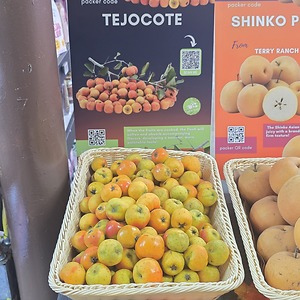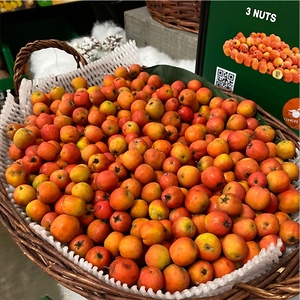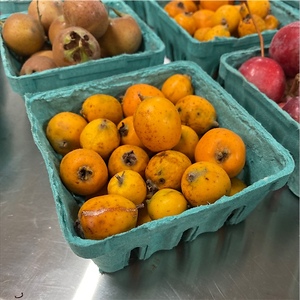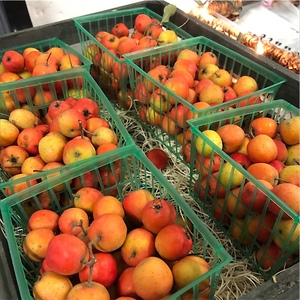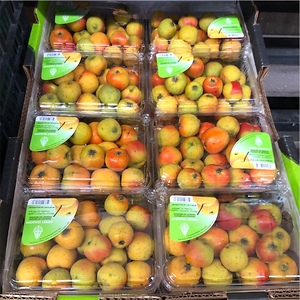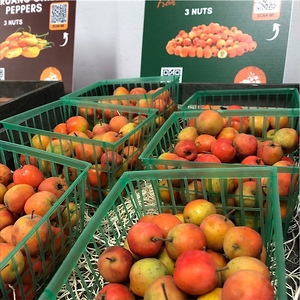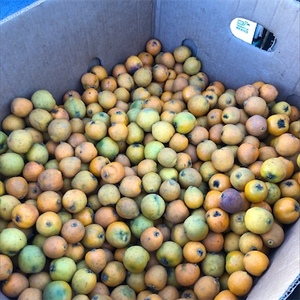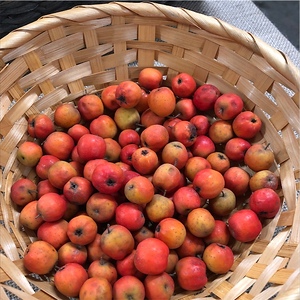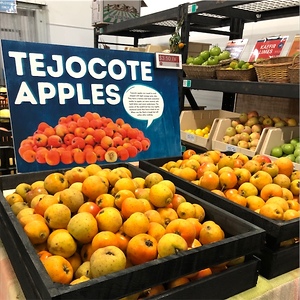


Tejocote Fruits
Estimated Inventory, lb : 0
This item was last sold on : 12/01/24
Description/Taste
Tejocote fruits are small, averaging 1 to 3 centimeters in diameter, and have a round, oval, to ovate shape with a slightly lumpy nature. The fruits are attached to slender fibrous stems and grow in pairs along branches with dark green leaves. The fruit's thin skin is smooth with a light, textured feel and bears variegated hues of bright yellow, pink, orange, and red. The skin is also frequently covered in black or ivory dots, freckles, and patches. Underneath the surface, the yellow to cream-colored flesh is soft, dry, mealy, and pithy, encasing 3 to 5 hard, dark brown seeds. It is important to note that the flesh immediately oxidizes once exposed to the air and turns a muddy shade. Tejocote fruits release a sweet and subtly tropical aroma and have a mild, astringent, sour, and sweet flavor with green, plum-like notes. When the fruits are cooked, the flesh will soften and absorb accompanying flavors, developing a sweeter, more palatable taste.
Seasons/Availability
Tejocote fruits are available in the fall through winter.
Current Facts
Tejocote fruit, botanically classified as Crataegus Mexicana, is the common name for pome fruits belonging to the Rosaceae family. The tiny, apple-like fruits grow on compact trees or shrubs reaching 4 to 9 meters in height and are a species of Mexican hawthorn native to Mexico. There are over sixteen species of Tejocote fruits, all found in Mexico, and the fruits are abundant in the wild, traditionally found throughout the Mexican highlands. The name Tejocote is derived from "texocotl," a word from the Aztec Nahuatl language roughly translating to mean “a fruit that is bitter, acidic, and hard as stone.” The fruits are also known as Manzanita, meaning "little apple," but it is important to note that despite their similarity in appearance to apples, Tejocote fruits are only distantly related. Tejocote fruits are a widespread foraged crop in Mexico and are planted in home gardens as an ornamental, medicinal, and culinary addition. The fruits are deeply intertwined into various Mexican religious and cultural traditions and are typically incorporated into culinary dishes, holiday candies, punches, and sauces.
Nutritional Value
Tejocote fruits have been used for centuries in natural medicines practiced throughout Mexico to relieve symptoms associated with sickness, diarrhea, and indigestion. The fruits are valued for their vitamin C content to strengthen the immune system while reducing inflammation and are commonly boiled into syrups and consumed as a cough, sore throat, and overall cold reliever. Tejocote fruits also provide antioxidants to protect the cells against the damage caused by free radicals, vitamin A to maintain healthy organ functioning, calcium to build strong bones and teeth, and other nutrients, including B vitamins, iron, and other minerals.
Applications
Tejocote fruits have a mild, somewhat neutral taste and can be eaten fresh, but they are generally preferred cooked to reduce the flesh’s astringency. When raw, Tejocote fruits can be consumed straight, out-of-hand, sliced, deseeded, and tossed into salads, or chopped into salsa and relishes. In addition to fresh applications, Tejocote fruits contain high pectin, acting as a natural thickener in jams, jellies, marmalades, and sauces for roasted meats. The fruits can also be added to soups, incorporated as a tamale filling, cooked with vegetables in chicken broth, simmered in sugar, cinnamon, and water as a candied treat, or cooked into fruit cheese, a spread similar to quince paste. In Mexico, Tejocote fruits were often preserved in syrup and were eaten in the winter when other fruits weren't historically available. The fruits are still widely incorporated into culinary preparations in the modern day and are famously used in ponche, a traditional holiday punch. The warm beverage combines Tejocote fruits with spices, guava, and sugar cane, but there are many other variations using piloncillo or dark brown sugar, oranges, apples, tamarind, and hibiscus flowers. Ponche is closely tied with the Day of Guadalupe to Ephiphany, a celebration commemorating the journey of Joseph and Mary from Nazareth to Bethlehem before the birth of Jesus. During Christmas, Tejocote fruits are also seasonally used as a pinata prize, stuffed whole with oranges, peanuts, and tangerines into the pinata. Beyond culinary preparations, Tejocote fruits can be blended and strained into cocktails and fruit punches or canned for extended use. Tejocote fruits pair well with meats such as pork, poultry, and turkey, fruits such as oranges, tangerines, apples, and guavas, spices such as cinnamon, nutmeg, and anise, brown sugar, and cane sugar. Whole Tejocote fruits will keep up to one week when stored in a plastic bag in the refrigerator.
Ethnic/Cultural Info
Tejocote fruits are a traditional food placed on altars during the Day of The Dead celebrations in Mexico. The nationally recognized holiday can be traced back to pre-Hispanic times when the Aztecs worshipped Mictecacihuatl, the goddess of death and ruler over festivals of the dead. While the Aztec ritual commonly lasted for a month, the celebrations have been shortened over time, typically celebrated between October 28th and November 2nd. During the Day of The Dead celebrations, families create altars dedicated to the deceased as a symbol of remembrance. They also place fruits and snacks on the altars to nourish traveling spirits as they make their way into the afterlife. Tejocote fruits are one of the main decorative and edible fruits used on altars and are strung into garlands, necklaces, or rosaries, draped as decoration and given as an offering. The small fruits are also often paired with oranges, seen as a symbol of fresh food in the winter season when fruits were typically difficult to find. Beyond raw preparations, Tejocote fruits are cooked in a spiced syrup, known as dulce de Tejocote, and are placed as a sweet treat on the altars as a snack for the spirits. The fruits are also cooked with sugar and chili powder to make rielitos, a type of Mexican candy, and are placed on small plates to display on the altars.
Geography/History
Tejocote fruits grow on Mexican Hawthorn trees native to the Sierra Madre Occidental mountain range in Central Mexico and have been growing wild since ancient times. The fruits were collected by indigenous peoples in the early ages and were planted near their settlements, extending the species' spread into Southern Mexico and Guatemala. Over time, Tejocote fruits were grown in villages and home gardens and were domesticated with growers selecting the seeds of favored trees with specific fruit qualities. In the wild, Mexican Hawthorn trees are commonly found in meadows, disturbed areas, and along forest edges in temperate climates. Tejocote fruits have remained an essential element in holiday celebrations in Mexico throughout history, and in the 21st century, the fruits became a heavily debated topic between Mexico and the United States. Tejocotes were the most smuggled fruits into the United States between 20022 and 2006, according to the United States Department of Agriculture, and it was said that more than 9,000 pounds of fruits were confiscated in one year. The fruits were illegal to import due to fruit fly larvae living on the fruits. Fruit flies are destructive and have the ability to decimate agricultural crops. Despite Mexican Hawthorn trees having been introduced to California in the early 20th century by botanist Francesco Franceschi for many years, it was a species largely ignored in American cultivation. The USDA, in partnership with the University of California, Riverside, worked with Southern California growers to plant commercial Mexican Hawthorns, and the first orchard was established in San Diego in the 1990s. These commercial farms, along with the legal import of Tejocote fruits in the early 21st century, drastically decreased the number of smuggled fruits across the border. Today Tejocote fruits are cultivated on a small scale in the United States and are sold through Mexican markets, specialty distributors, and farmer's markets. In Mexico, the fruits still grow wild and are primarily produced in the states of Puebla, Nuevo Leon, Veracruz, Coahuila, Tamaulipas, and San Luis Potosi. Tejocote fruits are also grown in Guatemala and have been planted in select regions of the Andes Mountains in South America.
Recipe Ideas
Recipes that include Tejocote Fruits. One



